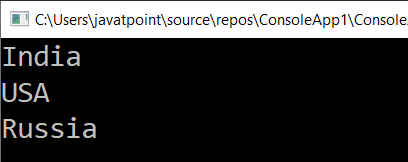📌 相关文章
- LINQ |分区运算符|拿
- LINQ |分区运算符|边走边走
- LINQ分区运算符(1)
- LINQ分区运算符
- LINQ |分区运算符|拿(1)
- LINQ |分区运算符|边走边走(1)
- LINQ |分区运算符|跳过而(1)
- LINQ |分区运算符|跳过而
- LINQ |分区运算符|跳过
- LINQ |分区运算符|跳过(1)
- LINQ TakeWhile分区运算符
- LINQ TakeWhile分区运算符(1)
- LINQ元素运算符
- LINQ元素运算符(1)
- LINQ排序运算符
- LINQ排序运算符(1)
- LINQ-查询运算符
- LINQ-查询运算符(1)
- LINQ生成运算符
- LINQ生成运算符(1)
- 在分区 (1)
- LINQ |元素运算符|最后的
- linq c# 或 - C# (1)
- linq c# (1)
- LINQ跳过运算符
- LINQ跳过运算符(1)
- LINQ GroupBy运算符
- LINQ GroupBy运算符(1)
- 在Hive中进行分区(1)
📜 LINQ进行分区运算符
📅 最后修改于: 2021-01-06 05:18:04 🧑 作者: Mango
LINQ进行分区运算符
在LINQ中,“取算符”用于从列表/集合中按顺序获取指定数量的元素。 LINQ要求操作员从集合或列表的开始处返回指定数量的元素。
我们将一个参数传递给LINQ Take()运算符,该运算符将指定要返回的元素数。
LINQ Take运算符的语法
LINQ Take运算符的语法是从列表/集合中返回指定数量的元素。
C#代码
IEnumerable result = countries.Take(3);
方法语法中的LINQ Take运算符示例
方法语法中的LINQ Takes()运算符示例从列表或集合中返回指定数量的元素。
C#代码
using System;
using System.Collections;
using System.Collections.Generic;
using System.Linq;
using System.Text;
using System.Threading.Tasks;
namespace ConsoleApp1
{
class Program
{
static void Main(string[] args)
{
//create an array countries of string type with the initialized array
string[] countries = { "India", "USA", "Russia", "China", "Australia", "Argentina" };
//here take() method will return the value from the String array upto three numbers.
IEnumerable result = countries.Take(3);
foreach (string s in result)
{
Console.WriteLine(s);
}
Console.ReadLine();
}
}
}
上面的程序显示我们有一个包含国家的字符串数组。在这里,我们要显示数组中仅有的前三个国家。这就是为什么我们使用Take运算符并传递count运算符,以便它返回数组中元素数量的原因。
输出:

查询语法中的LINQ Take()运算符示例
如果我们在查询语法中使用LINQ Take()运算符,示例将如下所示:
C#代码
using System;
using System. Collections;
using System.Collections.Generic;
using System. Linq;
using System. Text;
using System.Threading.Tasks;
namespace ConsoleApp1
{
class Program
{
static void Main(string[] args)
{
string[] countries = { "India", "USA", "Russia", "China", "Australia", "Argentina" };
IEnumerable result = (from x in countries select x).Take(3);
foreach (string s in result)
{
Console.WriteLine(s);
}
Console.ReadLine();
}
}
}
输出:
